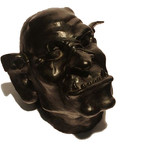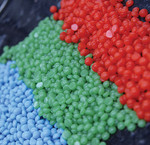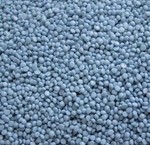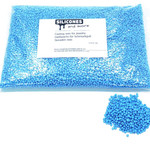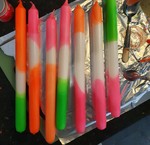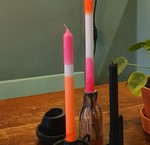Wax for art casting and precision investment casting
Wax is mainly used to make a temporary model. These models can then be used to make silicone molds or used directly in the lost wax method.
 Modelling Wax
Modelling Wax Casting wax
Casting wax Precision wax / filled wax
Precision wax / filled wax Artists Wax/ unfilled Wax
Artists Wax/ unfilled Wax Auxiliary Waxes
Auxiliary Waxes Tools
Tools Safety / PPE
Safety / PPE Wax dyes
Wax dyes Wax for candles
Wax for candles Waxes
Waxes
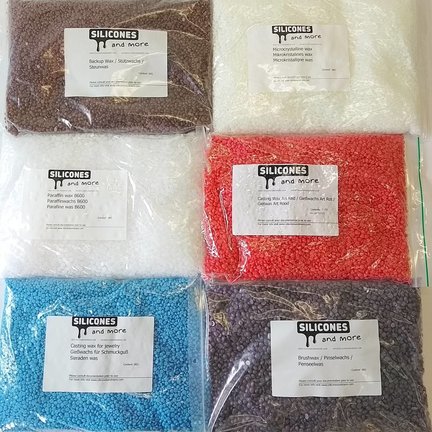
We supply waxes from the renowned manufacturer Remet. Remet is a leading wax formulator for the art foundry and precision foundry.
Raw material waxes
These waxes are often used as one of the raw materials in the further developed waxes below. They are therefore easy to combine.
Microcrystalline wax , often mixed with casting waxes to lower the melting temperature and lower the stiffness of a wax. This wax is also sometimes used as pure cast wax.
Paraffin waxes are often mixed with cast waxes to lower the melting temperature and lower the stiffness of a wax. These waxes are cheaper than microcrystalline waxes but also more granular.
Artists waxes / unfilled waxes
These waxes are widely used in manufacturing models or in making wax models for the lost wax method. Often the wax is brushed in a (silicone) mold or poured into a mold via the slush casting method. This wax does not contain any filler, which means that they are well fluid and do not have to be continuously stirred against demixing when heated up.
Modeling wax moderately hard is a wax that is intended for modeling a model. The wax is relatively hard, but becomes softer at body temperature. However, the wax is strong enough to also be used in hot locations for larger modeling work.
Modeling wax hard is a wax that is intended for modeling larger models or models that must remain very stable. This wax is easily moldable at body temperature but is stable enough for larger images.
Casting wax Art is a wax that is ideal for slush casting. The wax has relatively little shrinkage and gives a nice hard result. This makes it a good wax for warmer seasons and locations. The stiffness of the wax makes it easier to change small details with knives. The wax is difficult to spread. For repairs by means of wiping or smearing wax, one must then choose another wax or use a patch wax on this wax.
Casting wax 81 is an unfilled wax that is widely used in the precision foundry but also in the art foundry. This is a wax that is good to use as cast wax and as slush cast wax. This wax is slightly harder than the Gietwas Art and has less shrinkage.
Brush wax is a wax that can be beautifully coated with a brush in silicone molds. This ensures a great deal of detail, very little shrinkage and the absence of air bubbles. The brush wax is applied very thinly. A reinforcing wax layer must always be made behind the brush wax (back up wax or all round wax or microcrystalline wax).
Back up wax is a strong wax with a melting point that is just right to get enough adhesion with the brush wax or cast wax skin. The wax itself is strong and stiff.
All round wax is a very cheap wax that is relatively hard. This wax is used as (slush) pour wax and as back up wax. This wax is also often used to pour casting channels and venting channels in one go with the model.
Jewelry wax blue is specially made for the small jewelery. The wax works very well in silicone molds with high detail. The wax can be processed quickly and retains enough flexibility not to break when opening difficult models.
B95 is an unfilled wax specially developed for injection for models and casting channels of jewelry. This wax is flexible and gives a surface with sharp details. This wax has a lower melting point than the jewelry wax blue.
Precision waxes / filled waxes
These waxes are mainly used in the precision foundry. The filler ensures good dimensional stability (low shrinkage and incidence cavities). The filler often makes the wax thicker. Some filled waxes can only be processed with wax injection machines. Some waxes are only pasty processed. Filled waxes must be stirred continuously in the molten state to prevent separation (precipitation of the filler).
For client-specific waxes, we work together with Remet. This is the world leader in the field of wax and supplies for precision foundries. We are happy to discuss your wishes with you.
B76Ta light-filled wax specially intended for small to medium-sized models in the precision foundry. The melt viscosity is low resulting in good flow properties and an efficient de-wax result. The filler content is lower and the wax is tougher than B59. The melting point is also higher than B59.
B59a light-filled wax specially intended for small to medium-sized models in the precision foundry. The melt viscosity is low resulting in good flow properties and an efficient de-wax result. Melting point and hardness is lower than B76T. Filler content is higher than B76T which normally gives less shrinkage and fewer / smaller sinkholes.
B89a light-filled wax specially intended for small to medium-sized models in the aviation industry. This wax is well dimensionally stable, has a very high filler content, but is still fluid.
Auxiliary waxes
Adhesive wax is mainly used in precision foundries to adhere wax models to wax spouts and trees.
Repair wax Red is a somewhat greasy but very easily spreadable wax. This wax is used extensively in sealing and repairing unwanted cracks, cavities and dimples in wax models.
Repair wax White is a somewhat less greasy but still reasonably spreadable wax. This shaft is often used for repairing or quickly updating models and pouring channels
Water soluble wax is a wax that is mainly used in the manufacture of wax cores that cannot be removed by the burning process. These waxes dissolve in lukewarm to warm water, whether or not aided by acids.
Flexible wax is a wax with very high flexibility at room temperature. This wax is suitable for making flexible forms. This wax is also often mixed to make other waxes less brittle or less stiff. The wax venting ducts are made from this wax.


